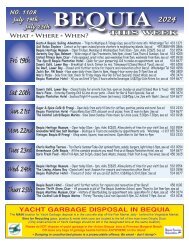Caribbean Compass Yachting Magazine - May/June 2022
Welcome to Caribbean Compass, the most widely-read boating publication in the Caribbean! THE MOST NEWS YOU CAN USE - feature articles on cruising destinations, regattas, environment, events...
Welcome to Caribbean Compass, the most widely-read boating publication in the Caribbean! THE MOST NEWS YOU CAN USE - feature articles on cruising destinations, regattas, environment, events...
You also want an ePaper? Increase the reach of your titles
YUMPU automatically turns print PDFs into web optimized ePapers that Google loves.
MAY/JUNE <strong>2022</strong> CARIBBEAN COMPASS PAGE 10<br />
CARIBBEAN<br />
ECO-NEWS<br />
TNC’s Impact in the <strong>Caribbean</strong><br />
The <strong>Caribbean</strong> is one of the most beautiful but<br />
vulnerable regions in the world, facing serious threats<br />
from climate change and other factors. In 2021, The<br />
Nature Conservancy (TNC) worked with partners and<br />
local communities to advance lasting conservation<br />
outcomes during a critical time for the <strong>Caribbean</strong> and<br />
our planet.<br />
Through a science-guided, nature-based approach,<br />
TNC is helping create a more resilient future for the<br />
region’s ocean and coastal communities with the<br />
following projects.<br />
• TNC’s mapping tool is an extension of the Mapping<br />
Ocean Wealth Data Explorer developed specifically to<br />
support the <strong>Caribbean</strong> Regional Oceanscape Project<br />
(CROP). The objective of CROP is to improve systems<br />
and put relevant structures in place in an effort to<br />
foster a Blue Economy and to promote greater<br />
consideration of the ecosystem functions and services<br />
that the ocean provides.<br />
Under CROP, TNC used the Mapping Ocean Wealth<br />
approach to develop ecosystem service models at the<br />
scale of the Eastern <strong>Caribbean</strong>. Existing coral reef<br />
tourism and fisheries models were adapted to the<br />
regional scale, and novel methodologies were developed<br />
to characterize recreational fishing and wildlife viewing<br />
in participating Eastern <strong>Caribbean</strong> countries<br />
(Dominica, Grenada, St. Kitts & Nevis, St. Lucia, and<br />
St. Vincent & the Grenadines). These data will support<br />
these countries in ongoing and future marine spatial<br />
planning through the direct provision of spatially<br />
explicit information on their ecosystem service values,<br />
particularly relating to fisheries and nature-based<br />
tourism. Use this data explorer to explore the mapped<br />
outputs of these models, along with country-specific<br />
reports and statistics.<br />
Read more about this project at oceanwealth.org/<br />
project-areas/caribbean/crop.<br />
• The Resilient Islands project identifies opportunities<br />
for leveraging nature-based solutions to help reduce<br />
disaster risks in three <strong>Caribbean</strong> coastal communities:<br />
Old Harbour Bay, Jamaica; Miches, the Dominican<br />
Republic; and Grenville, Grenada. Joining conservation<br />
with disaster-risk reduction, TNC helped develop<br />
nature-based action plans that empower communities<br />
to become stronger in the face of climate change.<br />
An analysis of vulnerability was conducted by<br />
intersecting social sensitivity, community adaptive<br />
capacity, and community exposure. This analysis<br />
identified high priority areas for investment, including<br />
Grenville Bay on the central east coast of Grenada. It<br />
also suggested that interventions in adaptive capacity<br />
would be most appropriate in this area.<br />
The Nature Conservancy began implementing the At<br />
the Water’s Edge (AWE) project, working with<br />
communities to strengthen their resilience to climate<br />
change in Grenville Bay. With the support of the<br />
Government of Grenada, community groups and<br />
project partners, the Grenada Red Cross Society and<br />
the Grenada Fund for Conservation, TNC embarked on<br />
a series of community engagements and educational<br />
outreach. This included training of persons,<br />
particularly fishers, in first aid, safety at sea and<br />
environmental education, and training of community<br />
members to collect, care for and out-plant mangroves<br />
seedlings in key areas along the coastline.<br />
HTTPS://SEESTJOHN.COM<br />
In 2015, 30 metres of hybrid pilot structures made with<br />
common local materials and designed to reduce wave<br />
energy reaching shore and promote natural biological<br />
growth and accretion of coral were installed on the<br />
northern reef. The full hybrid breakwater structures (300<br />
metres) should reduce 80 to 90 percent of wave energy<br />
and alongshore currents, thus reducing erosion and runup<br />
flooding at the beach. As the structures are seeded<br />
with corals and become reefs, they will grow and maintain<br />
their function while increasing marine life in the bay.<br />
TNC and the fishers have monitored the hybrid<br />
pilot since its installation. They are stable, are<br />
attracting a plethora of marine species such as<br />
lobsters, conchs (lambie), sea urchins and blue<br />
spotted stingrays, to name a few, they are reducing<br />
wave energy to the extent expected of the small pilot<br />
scale structures and are recruiting corals.<br />
The Nature Conservancy is helping<br />
create a healthier, more resilient future<br />
for the region’s coastal communities.<br />
In 2017, TNC and partners launched Reef Week, a<br />
biennial event held in the Grenville Bay Area to raise<br />
awareness of the importance of mangroves and coral<br />
reefs in local communities and schools. Students were<br />
taught about the degradation of the reefs in Grenville<br />
Bay and the impacts of that reef loss on coastal<br />
erosion and fisheries depletion, with the goal of<br />
instilling in the younger generation the importance of<br />
conserving and these coastal and marine habitats.<br />
Read the full story at https://bit.ly/3KZ6PNG<br />
Sea Urchins Are Dying<br />
According to an April 14th Associated Press report<br />
from Dánica Coto in San Juan, Puerto Rico, sea<br />
urchins are dying across the <strong>Caribbean</strong> at a pace<br />
scientists say could rival a mass die-off that last<br />
occurred in 1983.<br />
Dive shops first began reporting the deaths in<br />
February, and governments are receiving a growing<br />
number of reports about dying sea urchins in islands<br />
including Antigua, St. Lucia, Dominica, Jamaica, St.<br />
Vincent, Saba and the US Virgin Islands, as well as<br />
THE NATURE CONSERVANCY<br />
Cozumel in Mexico.<br />
“It’s very concerning, particularly because it’s<br />
happening so quickly,” said Patricia Kramer, a marine<br />
biologist and program director of the Atlantic and Gulf<br />
Rapid Reef Assessment (AGRRA), a scientific<br />
collaboration to improve reef conditions in the region.<br />
At first, the mortality event was linked only to black<br />
sea urchins (Diadema antillarum), which are<br />
recognizable by their extremely long, skinny spines.<br />
But two other species have since been affected,<br />
including the Rock Boring Sea Urchin and the West<br />
Indian Sea Egg.<br />
The deaths worry scientists including Dana<br />
Wusinich-Mendez, Atlantic-<strong>Caribbean</strong> team lead<br />
for the US National Oceanic and Atmospheric<br />
Administration’s coral reef conservation program:<br />
“Losing our sea urchins would be really devastating.”<br />
The deaths are of concern because sea urchins are<br />
herbivores known for being efficient grazers that<br />
remove macro algae from coral reefs and clear<br />
space for baby sea corals to attach themselves.<br />
While macro algae are an important source of food<br />
and shelter for some fish, too many of them can degrade<br />
coral reefs that are under stress by warmer-thanaverage<br />
ocean temperatures and stony coral tissue loss<br />
disease. Overfishing across the <strong>Caribbean</strong> already had<br />
led to a greater abundance of macro algae, which was<br />
kept in check by sea urchins that are now dying, said<br />
Shamal Connell, an officer with St. Vincent and the<br />
Grenadines’ Fisheries Service who oversees research.<br />
“It’s very urgent that we find a solution,” he said.<br />
AGRRA recently helped create a network to<br />
investigate the deaths, analyze tissue samples and<br />
find solutions. It includes the Florida-based Gulf and<br />
<strong>Caribbean</strong> Fisheries Institute and nearly two dozen<br />
groups in the <strong>Caribbean</strong> and US.<br />
Kramer noted that very few black sea urchin<br />
populations recovered from the 1983 event that began<br />
near the Panama Canal and spread northward and<br />
then eastward over the following 13 months. During<br />
that time, only the black sea urchin was affected, with<br />
90 percent or more of the population dying, though at<br />
a much slower rate than the current event. “Just when<br />
we’re getting to the point where they’re recovering,<br />
they’re dying,” Kramer said.<br />
The island of St. Thomas was the first to report the<br />
newest round of deaths, although it’s unclear whether<br />
that’s where the event started. In mid-March, Saba<br />
reported similar deaths, noting that 50 percent of the<br />
sea urchin population in its harbor was dead a week<br />
later. Officials in Saba said they have around 200 sea<br />
urchins in a nursery and are gathering information<br />
about the new mortality event, adding that they are<br />
treating some with antibiotics that might cure them<br />
or prevent them from getting sick.<br />
Meanwhile, Monique Calderon, a fisheries biologist<br />
with the government of St. Lucia, said scientists there<br />
are considering launching their own survey to get<br />
more details about where the sea urchins are dying<br />
and why. “When the last die-off occurred in the 1980s,<br />
the sampling done wasn’t robust enough to determine<br />
what the issue was exactly, what might have caused<br />
it,” Calderon said, adding that she hopes to find an<br />
explanation with improved technology.<br />
—Continued on next page<br />
Suddenly, healthy sea urchins like these are an<br />
increasingly rare sight. Researchers attempt<br />
to find out why.

















